![]() June 1996
June 1996
This month's features in our
pond-dipping issue:
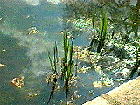
Regular readers of Micscape Magazine will know that the
contributors are particularly keen to sing the praises of
pond-dipping to the amateur microscopist. Youngsters have always
had a fascination for ponds, but seem to lose it as they grow
older. This is a pity because at any time of year there is a
wealth of both macroscopic and microscopic pond organisms for
naturalists both young and old to study.
In northern England where the author lives, a spell of cold
weather (our second coldest May since records began!) has slowed
the progress of early summer, so the author has concentrated this
month on some of the plant and animal organisms that can be found
in most bodies of freshwater.
Please read the important notes on collecting which also describes some simple precautions when pond-dipping.
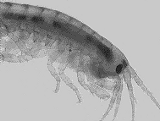 For the casual observer of freshwater life, very
little equipment is needed to become familiar with some of the
commoner pond organisms, either at the pond side with a 10X hand
lens or for taking home for closer examination. A more scientific
study of the ecology of a habitat and collection of particular
organisms requires more systematic techniques and specialist
equipment which may be discussed in a later article.
For the casual observer of freshwater life, very
little equipment is needed to become familiar with some of the
commoner pond organisms, either at the pond side with a 10X hand
lens or for taking home for closer examination. A more scientific
study of the ecology of a habitat and collection of particular
organisms requires more systematic techniques and specialist
equipment which may be discussed in a later article.
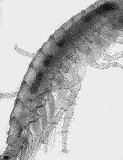 Freshwater shrimps (Gammarus) are
commonly found in cleaner ponds and streams where the calcium
concentration is high enough to support them. In Yorkshire,
England where the author lives Gammarus pulex is not
found in water bodies with a calcium content of less than about
10mg per litre.
Freshwater shrimps (Gammarus) are
commonly found in cleaner ponds and streams where the calcium
concentration is high enough to support them. In Yorkshire,
England where the author lives Gammarus pulex is not
found in water bodies with a calcium content of less than about
10mg per litre.
Go back to this Walk's Contents
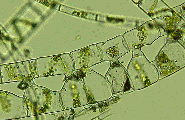 Algae are single-celled plants and include
microscopic forms less than 1 micron long to the giant seaweed
called kelp which can reach lengths of 60m. Many algae are very
attractive particularly if dark ground illumination is used. Most
ponds contain various filamentous algae and the green 'slime'
often found in ponds is composed of algae.
Algae are single-celled plants and include
microscopic forms less than 1 micron long to the giant seaweed
called kelp which can reach lengths of 60m. Many algae are very
attractive particularly if dark ground illumination is used. Most
ponds contain various filamentous algae and the green 'slime'
often found in ponds is composed of algae.
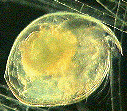 A group of organisms
in which the author has a particular interest is the 'water
fleas' a popular name for a group that includes Daphnia,
which are well known to aquarists as a fish food. Water fleas
were formerly grouped in the order Cladocera, although many
taxonomists now split them among four groups. However, Cladocera
is still a widely used descriptive term for them.
A group of organisms
in which the author has a particular interest is the 'water
fleas' a popular name for a group that includes Daphnia,
which are well known to aquarists as a fish food. Water fleas
were formerly grouped in the order Cladocera, although many
taxonomists now split them among four groups. However, Cladocera
is still a widely used descriptive term for them.
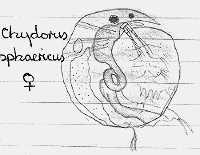 Cladocera are a
delight to study under the microscope and have fascinated the
author since he received his first microscope at ten years old. A
drawing made by the author when he was aged 12 is shown right as
proof! Chydorus sphaericus is a very common Cladoceran
in most ponds and may be found with similar species in the weed
samples described above. The Cladocera shown left above under
dark ground illumination is also a member of the Chydoridae
family. If mounted in a shallow cavity slide their structure,
beating heart and limb movement can be admired while they are
alive.
Cladocera are a
delight to study under the microscope and have fascinated the
author since he received his first microscope at ten years old. A
drawing made by the author when he was aged 12 is shown right as
proof! Chydorus sphaericus is a very common Cladoceran
in most ponds and may be found with similar species in the weed
samples described above. The Cladocera shown left above under
dark ground illumination is also a member of the Chydoridae
family. If mounted in a shallow cavity slide their structure,
beating heart and limb movement can be admired while they are
alive.
Go back to this Walk's Contents
Pond-life - Introductory guides.
1) Collins Field Guide to Freshwater Life
by R Fitter and R Manuel. Collins, London, 1986. ISBN 0 00
219143-1. A superb guide to the macroscopic and microscopic plant
and animal life of Britain and N. Europe and enables organisms to
be identified to at least the correct family and many to genus.
2) Freshwater Invertebrates. A Key to the Major Groups. by P S Croft. Field Studies Council, 1986. ISBN 1 85153 181 6. A good pond side guide to allow the macroscopic (> 2mm) invertebrates to be identified to family. Excellent for school students and can complement ref. 1.
Algae
3) A beginner's Guide to Freshwater Algae by H
Belcher and E Swale. Natural Environment Research Council 1978.
ISBN 0 11 881393 5. A good well-illustrated introduction.
Water fleas
4) A Key to the British Species of Freshwater
Cladocera by D J Scourfield and J P Harding. Freshwater
Biological Association, UK, 1994 reprint. This to the author's
knowledge is still the only guide to the British species in
print. It became a classic when first published in 1941, but
unfortunately the Freshwater Biological Association reprinted in
effect the 1958 Edition in 1994 without updating. It is still a
useful introduction but is woefully out of date.
5) Crustace Cladoceres by C Amoros. Bulletin de la Societe Linneenne de Lyon, 53e annee, no 3, mars 1984 p72-107. Although an introduction to the French Cladocera, most British species are covered and has a superb diagrammatic key which is a delight to use.
Macro images of the shrimp were taken using a CCD camera
attached to the eyepiece tube of a stereo microscope using a x1
paired objective with no eyepiece. Algae and water flea images
were taken using 9x or 20x objective without an eyepiece on a
compound microscope.
The pond image was captured from a video by the Microscopy UK
Editor Maurice Smith...thanks Maurice!
Camera images were transferred to the PC using a Creative Video
Spigot capture card.
Image manipulation using Photostyler v2.0 software.
The author Dave Walker
is a UK based amateur naturalist keen to encourage people to
explore nature in close-up.